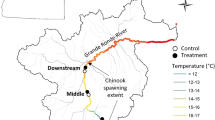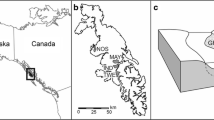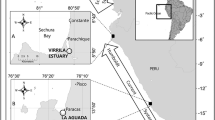Abstract
Anadromous fishes serve as vectors of marine-derived nutrients into freshwaters that are incorporated into aquatic and terrestrial food webs. Pacific salmonines Oncorhynchus spp. exemplify the importance of migratory fish as links between marine and freshwater systems; however, little attention has been given to sea lamprey (Petromyzon marinus Linnaeus, 1758) in Atlantic coastal systems. A first step to understanding the role of sea lamprey in freshwater food webs is to characterize the composition and rate of nutrient inputs. We conducted laboratory and field studies characterizing the elemental composition and the decay rates and subsequent water enriching effects of sea lamprey carcasses. Proximate tissue analysis demonstrated lamprey carcass nitrogen:phosphorus ratios of 20.2:1 (±1.18 SE). In the laboratory, carcass decay resulted in liberation of phosphorus within 1 week and nitrogen within 3 weeks. Nutrient liberation was accelerated at higher temperatures. In a natural stream, carcass decomposition resulted in an exponential decline in biomass, and after 24 days, the proportion of initial biomass remaining was 27% (±3.0% SE). We provide quantitative results as to the temporal dynamics of sea lamprey carcass decomposition and subsequent nutrient liberation. These nutrient subsidies may arrive at a critical time to maximize enrichment of stream food webs.


Similar content being viewed by others
References
Beamish, F. W. H., 1980. Biology of the North American anadromous sea lamprey, Petromyzon marinus. Canadian Journal of Fisheries and Aquatic Sciences 37: 1924–1943.
Bilby, R. E., B. R. Fransen & P. A. Bisson, 1996. Incorporation of nitrogen and carbon from spawning coho salmon into the trophic system of small streams: evidence from stable isotopes. Canadian Journal of Fisheries and Aquatic Sciences 53: 164–173.
Bowen, H. J. M., 1966. Trace Elements in Biochemistry. Academic Press, London.
Chaloner, D. T., K. M. Martin, M. S. Wipfli, P. H. Ostrom & G. A. Lamberti, 2002. Marine carbon and nitrogen in southeastern Alaska stream food webs: evidence from artificial and natural streams. Canadian Journal of Fisheries and Aquatic Sciences 59: 1257–1265.
Cederholm, C. J., D. B. Houston, D. L. Cole & W. J. Scarlett, 1989. Fate of coho salmon (Oncorhynchus kisutch) carcasses in spawning streams. Canadian Journal of Fisheries and Aquatic Sciences 46: 1347–1355.
Cederholm, C. J., M. D. Kunze, T. Murota & A. Sibatani, 1999. Pacific Salmon carcasses: essential contributions of nutrients and energy for aquatic and terrestrial ecosystems. Fisheries 24(10): 6–15.
Claeson, S. M., J. L. Li, J. E. Compton & P. A. Bisson, 2006. Response of nutrients, biofilm, and benthic insects to salmon carcass addition. Canadian Journal of Fisheries and Aquatic Sciences 63: 1230–1241.
Cummins, K. W., 1974. Structure and function of stream ecosystems. Bioscience 24: 631–641.
Dantas, M. C. & J. L. Attayde, 2007. Nitrogen and phosphorus content of some temperate and tropical freshwater fishes. Journal of Fish Biology 70: 100–108.
Driscoll, C. T., G. B. Lawrence, A. J. Bulger, T. J. Butler, C. S. Cronan, C. Eagar, K. F. Lambert, G. E. Likens, J. L. Stoddard & K. C. Weathers, 2001. Acidic deposition in the Northeastern United States: sources and inputs, ecosystem effects, and management strategies. Bioscience 51: 180–198.
Durbin, A. G., S. W. Nixon & C. A. Oviatt, 1979. Effects of the spawning migration of the alewife, Alosa pseudoharengus, on freshwater ecosystems. Ecology 60: 8–17.
Elser, J. J., D. R. Dobberfuhl, N. A. MacKay & J. H. Schampel, 1996. Organism size, life history, and N:P stoichiometry. Bioscience 46: 674–684.
Fenoglio, S., T. Bo, M. Cammarata, G. Malacarne & G. Del Frate, 2010. Contribution of macro- and micro-consumers to the decomposition of fish carcasses in low-order streams: an experimental study. Hydrobiologia 637: 219–228.
Garman, G. C. & S. A. Macko, 1998. Contribution of marine-derived organic matter to an Atlantic coast, freshwater, tidal stream by anadromous clupeid fishes. Journal of the North American Benthological Society 17: 277–285.
Gende, S. M., R. T. Edwards, M. F. Willson & M. S. Wipfli, 2002. Pacific salmon in aquatic and terrestrial ecosystems. Bioscience 52: 917–928.
Gustafson-Greenwood, K. I. & J. R. Moring, 1990. Territory size and distribution of newly-emerged Atlantic salmon (Salmo salar). Hydrobiologia 206: 125–131.
Guyette, M. Q., C. S. Loftin & J. Zydlewski, 2013. Carcass analog addition enhances juvenile Atlantic salmon (Salmo salar) growth and condition. Canadian Journal of Fisheries and Aquatic Sciences 70: 860–870.
Guyette, M. Q., C. S. Loftin, J. Zydlewski & R. Cunjak, 2014. Carcass analogues provide marine subsidies for macroinvertebrates and juvenile Atlantic salmon in temperate oligotrophic streams. Freshwater Biology 59: 392–406.
Hall, C. A. S., 1972. Migration and metabolism in a temperate stream ecosystem. Ecology 53: 585–604.
Hall, C. J., A. Jordaan & M. G. Frisk, 2011. The historic influence of dams on diadromous fish habitat with a focus on river herring and hydrologic longitudinal connectivity. Landscape Ecology 26: 95–107.
Holtgrieve, G. W. & D. E. Schindler, 2011. Marine-derived nutrients, bioturbation, and ecosystem metabolism: reconsidering the role of salmon in streams. Ecology 92: 373–385.
Jauquet, J., N. Pittman, J. A. Heinis, S. Thompson, N. Tatyama & J. Cederholm, 2003. Observations of chum salmon consumption by wildlife and changes in water chemistry at Kennedy Creek during 1997–2000. In Stockner, J. G. (ed.), Nutrients in Salmonid Production and Biodiversity. American Fisheries Society, Bethesda, MD: 71–88.
Johnson, L. T., J. L. Tank & W. K. Dodds, 2009. The influence of land use on stream biofilm nutrient limitation across eight North American ecoregions. Canadian Journal of Fisheries and Aquatic Sciences 66: 1081–1094.
Johnston, N. T., E. A. MacIsaac, P. J. Tschaplinski & K. J. Hall, 2004. Effects of the abundance of spawning sockeye salmon (Oncorhynchus nerka) on nutrients and algal biomass in forested streams. Canadian Journal of Fisheries and Aquatic Sciences 61: 384–403.
Kelso, B. H. L., R. V. Smith, R. J. Laughlin & S. D. Lennox, 1997. Dissimilatory nitrate reduction in anaerobic sediments leading to river nitrite accumulation. Applied and Environmental Microbiology 63: 4679–4685.
Kitchell, J. F., R. V. O’Neill, D. Webb, G. W. Gallepp, S. M. Bartell, J. F. Koonce & B. S. Ausmus, 1979. Regulation of nutrient cycling. Bioscience 29: 28–34.
Kohler, A. E., A. Rugenski & D. Taki, 2008. Stream food web response to a salmon carcass analog addition in two central Idaho, U.S.A. streams. Freshwater Biology 53: 446–460.
Lamberti, G. A., D. T. Chaloner & A. E. Hershey, 2010. Linkages among aquatic ecosystems. Journal of the North American Benthological Society 29: 245–263.
Lessard, J. L. & R. W. Merritt, 2006. Influence of marine-derived nutrients from spawning salmon on aquatic insect communities in southeast Alaskan streams. Oikos 113: 334–343.
Levi, P. S., J. L. Tank, J. Ruegg, D. J. Janetski, S. D. Tiegs, D. T. Chaloner & G. A. Lamberti, 2013. Whole-stream metabolism responds to spawning Pacific salmon in their native and introduced ranges. Ecosystems 16: 269–283.
Limburg, K. E. & J. R. Waldman, 2009. Dramatic declines in North Atlantic diadromous fishes. Bioscience 59: 955–965.
Lovern, J. A., 1938. Fat metabolism in fishes: seasonal changes in the composition of herring fat. The Biochemical Journal 32: 676–680.
Lyle, A. A. & J. M. Elliott, 1998. Migratory salmonids as vectors of carbon, nitrogen and phosphorus between marine and freshwater environments in north-east England. The Science of the Total Environment 210: 457–468.
MacFarlane, G. T. & R. A. Herbert, 1984. Dissimilatory nitrate reduction and nitrification in estuarine sediments. Journal of General Microbiology 130: 2301–2308.
Merritt, R. W., K. W. Cummins & M. B. Berg, 2008. An Introduction to the Aquatic Insects of North America, 4th ed. Kendall/Hunt Publishing Co., Dubuque, IA.
Minakawa, N. & R. I. Gara, 1999. Ecological effects of a chum salmon (Oncorhynchus keta) spawning run in a small stream of the Pacific Northwest. Journal of Freshwater Ecology 14: 327–335.
Minshall, G. W., E. Hitchcock & J. R. Barnes, 1991. Decomposition of rainbow trout (Oncorhynchus mykiss) carcasses in a forest stream ecosystem inhabited only by nonanadromous fish populations. Canadian Journal of Fisheries and Aquatic Sciences 48: 191–195.
Mitchell, N. L. & G. A. Lamberti, 2005. Responses in dissolved nutrients and epilithon abundance to spawning salmon in southeast Alaska streams. Limnology and Oceanography 50: 217–227.
Nagler, J. J., S. M. Ruby, D. R. Idler & Y. P. So, 1987. Serum phosphoprotein phosphorus and calcium levels as reproductive indicators of vitellogenin in highly vitellogenic mature female and estradiol-injected immature rainbow trout (Salmo gairdneri). Canadian Journal of Zoology 65: 2421–2425.
Naiman, R. J., R. E. Bilby, D. E. Schindler & J. M. Helfield, 2002. Pacific salmon, nutrients, and the dynamics of freshwater and riparian ecosystems. Ecosystems 5: 399–417.
Nislow, K. H., C. Folt & M. Seandel, 1998. Food and foraging behavior in relation to microhabitat use and survival of age-0 Atlantic salmon. Canadian Journal of Fisheries and Aquatic Sciences 55: 116–127.
Nislow, K. H. & B. E. Kynard, 2009. The role of anadromous sea lamprey in nutrient and material transport between marine and freshwater environments. In Haro, A., K. L. Smith, R. A. Rulifson, C. M. Moffitt, R. J. Klauda, M. J. Dadswell, R. A. Cunjak, J. E. Cooper, K. L. Beal & T. S. Avery (eds.), Challenges for Diadromous Fishes in a Dynamic Global Environment. American Fisheries Society, Bethesda, MD: 485–494.
Omernik, J. M., 1977. Ecoregions of the conterminous United States. Annals of the Association of American Geographers 77: 118–125.
Parmenter, R. R. & V. A. Lamarra, 1991. Nutrient cycling in a freshwater marsh: the decomposition of fish and waterfowl carrion. Limnological Oceanography 36: 976–987.
Pearsons, T. N., D. D. Roley & C. L. Johnson, 2007. Development of a carcass analog for nutrient restoration in streams. Fisheries 32(3): 114–124.
Penobscot River Restoration Trust, 2015. Home page of the Penobscot River Restoration Trust. Accessed 12 February, 2015, from http://www.penobscotriver.org/.
Pess, G. R., T. P. Quinn, S. R. Gephard & R. Saunders, 2014. Re-colonization of Atlantic and Pacific rivers by anadromous fishes: linkages between life history and the benefits of barrier removal. Reviews in Fish Biology and Fisheries 24: 881–900.
Polis, G. A., W. B. Anderson & R. D. Holt, 1997. Toward an integration of landscape and food web ecology: the dynamics of spatially subsidized food webs. Annual Review of Ecology, Evolution, and Systematics 28: 289–316.
Quinn, T. P., 2005. The behavior and ecology of Pacific salmon and trout, 1st ed. University of Washington Press, Seattle, WA.
Ruegg, J., S. D. Tiegs, D. T. Chaloner, P. S. Levi, J. L. Tank & G. A. Lamberti, 2011. Salmon subsidies alleviate nutrient limitation of benthic biofilms in southeast Alaska streams. Canadian Journal of Fisheries and Aquatic Sciences 68: 277–287.
Saunders, R., M. A. Hachey & C. W. Fay, 2006. Maine’s diadromous fish community: past, present, and implications for Atlantic salmon recovery. Fisheries 31(11): 537–547.
Sheer, M. B. & E. A. Steel, 2006. Lost watersheds: barriers, aquatic habitat connectivity, and salmon persistence in the Willamette and Lower Columbia River basins. Transactions of the American Fisheries Society 135: 1654–1669.
Smith, R. A., R. B. Alexander & G. E. Schwarz, 2003. Natural background concentrations of nutrients in streams and rivers of the conterminous United States. Environmental Science & Technology 37: 3039–3047.
Sokal, R. R. & F. J. Rohlf, 2012. Biometry: The Principles and Practices of Statistics in Biological Research, 4th ed. W.H. Freeman & Co., New York.
Stansby, M. E. & A. S. Hall, 1965. Chemical composition of commercially important fish of the United States. Fishery Industrial Research 3: 29–46.
Sumner, F. H., 1953. Migrations of salmonids in Sand Creek, Oregon. Transactions of the American Fisheries Society 82: 139–150.
Sweeney, B. W., T. L. Bott, J. K. Jackson, L. A. Kaplan, J. Denis Newbold, L. J. Standley, W. Cully Hession & R. J. Horwitz, 2004. Riparian deforestation, stream narrowing, and loss of stream ecosystem services. Proceedings of the National Academy of Sciences 101: 14132–14137.
Tank, J. L. & W. K. Dodds, 2003. Nutrient limitation of epilithic and epixylic biofilms in ten North American streams. Freshwater Biology 48: 1031–1049.
Tanner, D. K., J. C. Brazner & V. J. Brady, 2000. Factors influencing carbon, nitrogen, and phosphorus content of fish from a Lake Superior coastal wetland. Canadian Journal of Fisheries and Aquatic Sciences 57: 1243–1251.
Tilman, D., 1982. Resource competition and community structure. Princeton University Press, Princeton, NJ.
Walters, A. W., R. T. Barnes & D. M. Post, 2009. Anadromous alewives (Alosa pseudoharengus) contribute marine-derived nutrients to coastal stream food webs. Canadian Journal of Fisheries and Aquatic Sciences 66: 439–448.
Weitkamp, L. A., G. Goulette, J. Hawkes, M. O’Malley & C. Lipsky, 2014. Juvenile salmon in estuaries: comparisons between North American Atlantic and Pacific salmon populations. Reviews in Fish Biology and Fisheries 24: 713–736.
Williams, K. L., S. W. Griffiths, S. McKelvey & J. D. Armstrong, 2010. Deposition of Atlantic salmon Salmo salar carcasses in a Scottish upland catchment. Journal of Fish Biology 77: 927–934.
Wipfli, M. S. & C. V. Baxter, 2010. Linking ecosystems, food webs, and fish production: subsidies in salmonid watersheds. Fisheries 35(8): 373–387.
Wipfli, M. S., J. Hudson & J. Caouette, 1998. Influence of salmon carcasses on stream productivity: response of biofilm and benthic macroinvertebrates in southeastern Alaska, U.S.A. Canadian Journal of Fisheries and Aquatic Sciences 55: 1503–1511.
Wipfli, M. S., J. P. Hudson, J. P. Caouette & D. T. Chaloner, 2003. Marine subsidies in freshwater ecosystems: salmon carcasses increase the growth rates of stream-resident salmonids. Transactions of the American Fisheries Society 132: 371–381.
Wipfli, M. S., J. P. Hudson, J. P. Caouette, N. L. Mitchell, J. L. Lessard, R. A. Heintz & D. T. Chaloner, 2010. Salmon carcasses increase stream productivity more than inorganic fertilizer pellets: a test on multiple trophic levels in streamside experimental channels. Transactions of the American Fisheries Society 139: 824–839.
Whitehead, C., N. R. Bromage & J. R. M. Forster, 1978. Seasonal changes in reproductive function of the rainbow trout (Salmo gairdneri). Journal of Fish Biology 12: 601–608.
Woodhead, P. M. J., 1968. Seasonal changes in the calcium content of the blood of arctic cod. Journal of the Marine Biological Association of the United Kingdom 48: 81–91.
Young, R. G., C. D. Matthaei & C. R. Townsend, 2008. Organic matter breakdown and ecosystem metabolism: functional indicators for assessing river ecosystem health. Journal of the North American Benthological Society 27: 605–625.
Zar, J. H., 1999. Biostatistical analysis, 4th ed. Prentice-Hall, Upper Saddle River, NJ.
Acknowledgments
We thank Lara Katz and Neil Greenberg from the University of Maine for the field and laboratory assistance and Bill Halteman for statistical guidance. Hamish Greig and two anonymous reviewers improved earlier versions of this manuscript. Oliver Cox and Richard Dill from the Maine Department of Marine Resources provided technical assistance in collecting fish. This work was supported in part by the U.S. Geological Survey, Maine Cooperative Fish and Wildlife Research Unit, the National Oceanic and Atmospheric Administration, and the University of Maine Department of Wildlife, Fisheries, and Conservation Biology. This work is Maine Agriculture and Forest Experiment Station Publication Number 3408 and is based on research supported in part by Hatch Grant number ME0-H-6-00508-138367-0H from the USDA National Institute of Food and Agriculture. This research was performed under University of Maine approved Institutional Animal Care and Use Committee Protocol Number A2011-06-03. Any use of trade, firm, or product names is for descriptive purposes only and does not imply endorsement by the U.S. Government.
Author information
Authors and Affiliations
Corresponding author
Additional information
Handling editor: M. Power
Rights and permissions
About this article
Cite this article
Weaver, D.M., Coghlan, S.M., Zydlewski, J. et al. Decomposition of sea lamprey Petromyzon marinus carcasses: temperature effects, nutrient dynamics, and implications for stream food webs. Hydrobiologia 760, 57–67 (2015). https://doi.org/10.1007/s10750-015-2302-5
Received:
Revised:
Accepted:
Published:
Issue Date:
DOI: https://doi.org/10.1007/s10750-015-2302-5




